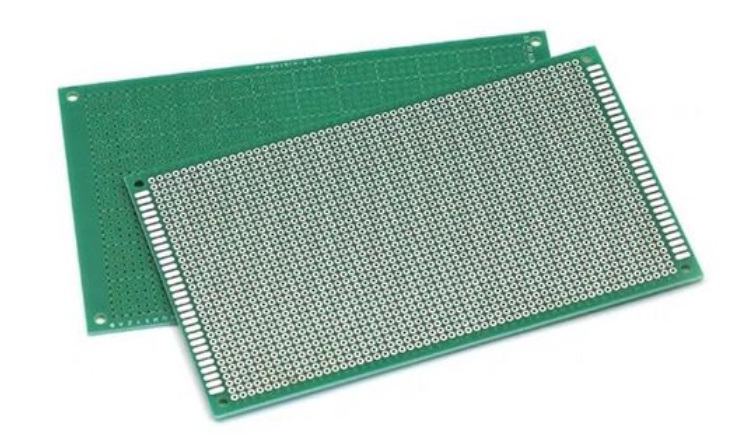Single-sided PCB is a type of printed circuit board. Only one side of the PCB board has wiring (which can have holes or no holes), and the other side is covered with the substrate or direct insulating ink, without any wiring, and the entire board is transparent under strong light (excluding individual boards and special process requirements). Only the side with lines on the transverse section contains copper foil.

Single-sided PCB
Overview of Single-sided PCB
A single-sided PCB consists of a single circuit and electronic components. This module is suitable for simple electronic products such as calculators, toys, etc. At the same time, single-sided PCB is also the type of circuit board that beginners usually design and build first. Compared with other types of circuit boards, single-sided PCB has lower costs and lower production process requirements. However, due to their design limitations, their application of products is limited.
Generally speaking, single-sided PCB is obtained by etching copper-coated boards. The copper-clad plate consists of a plate base and copper foil, which are usually made of insulating materials such as glass fiber and covered with a layer of copper foil (usually oxygen-free copper). After etching, copper foil is left with sections of twisted and twisted copper foil, which are called traces. These wiring functions are equivalent to the wiring in the circuit schematic, which is responsible for connecting the pins of the components. There are some holes drilled into the copper foil for installing electronic components, called drilling holes. The copper foil used for soldering with component pins is called a pad. Single-sided PCB can provide mechanical support for fixing and assembling electronic components and can achieve electrical connection or insulation between electronic components. In addition, we can also see that many single-sided PCB is printed with component numbers and some graphics, which provides convenience for component insertion, inspection, and maintenance.
The purpose of a single-sided PCB
LCD and FPC industries; Barrier materials for the chemical industry; Electrical isolation materials; Release materials, insulation materials, and heat insulation materials; Conveyor belt; Copper laminated sheet; Other industries.
The single-sided PCB substrate material mainly consists of paper phenolic copper laminated board and paper epoxy resin copper laminated board. Single-sided PCB are mostly used in household appliances such as radios, heaters, refrigerators, and washing machines, as well as commercial machines such as printers, vending machines, circuit machines, and electronic components.
Type of material used for single-sided PCB
1. Phenolic paper substrate, commonly known as cardboard, adhesive board, V0 board, flame retardant board, red letter copper clad board, 94V0. The most commonly used product models for the phenolic paper-based copper-clad board are FR-1 (flame retardant) and XPC (non-flame retardant). The single-sided copper-clad board can be easily judged by the color of the characters behind the board, usually with red letters indicating FR-1 (flame retardant) and blue letters indicating XPC (non-flame retardant). This type of board is the cheapest compared to other types of boards.
2. Epoxy fiberglass cloth substrate (commonly known as the epoxy board, fiberglass board, fiberboard, FR4) is a type of substrate that uses epoxy resin as the adhesive and electronic grade fiberglass cloth as the reinforcing material. Its adhesive sheet and thin copper-clad inner core are important substrates for producing multi-layer printed circuit boards. The working temperature is relatively high, and its performance is less affected by the environment. In terms of processing technology, it has great advantages over other resin-based fiberglass cloth boards. This type of product is mainly used for double-sided PCBs, which are also about twice as expensive as phenolic paper substrates, with a commonly used thickness of 1.5MM.
3. Composite substrate (commonly referred to as powder board, etc., also known as 22F in some parts of China) mainly refers to CEM-1 and CEM-3 composite copper-clad laminates. A copper-clad plate made of wood pulp fiber paper or cotton pulp fiber paper as the core material reinforcement material, glass fiber cloth as the surface reinforcement material, and both immersed in flame retardant epoxy resin are called CEM-1. The copper-clad plate made of glass fiber paper as the core material reinforcement material and glass fiber cloth as the surface reinforcement material, both immersed in flame retardant epoxy resin, is called CEM-3. These two types of copper-clad plates are the most common composite-based copper-clad plates. This type of plate is cheaper than the FR4 type plate.
Characteristics of Single-sided PCB
A single-sided PCB is the most basic PCB board, with parts concentrated on one side and wires concentrated on the other side. Because wires only appear on one side, we call this type of PCB a single panel.
1. Due to the repeatability and consistency of graphics, errors in wiring and assembly are reduced, saving time for equipment maintenance, debugging, and inspection
2. Design can be standardized, facilitating interchangeability
3. High wiring density, small size, and lightweight are conducive to the miniaturization of electronic equipment
4. It is conducive to mechanized and automated production, improves labor productivity, and reduces the cost of electronic equipment.
Single-sided PCB can provide mechanical support for fixing and assembling electronic components and can achieve electrical connection or insulation between electronic components.